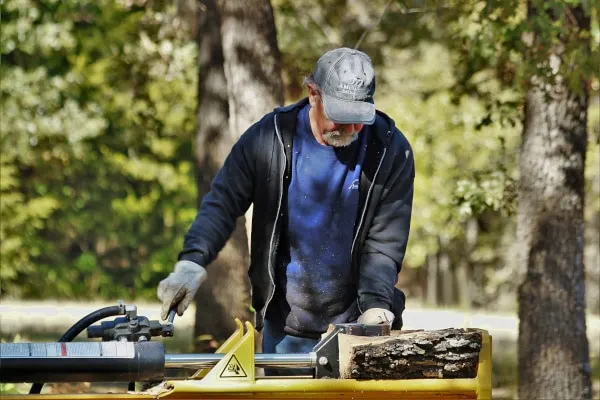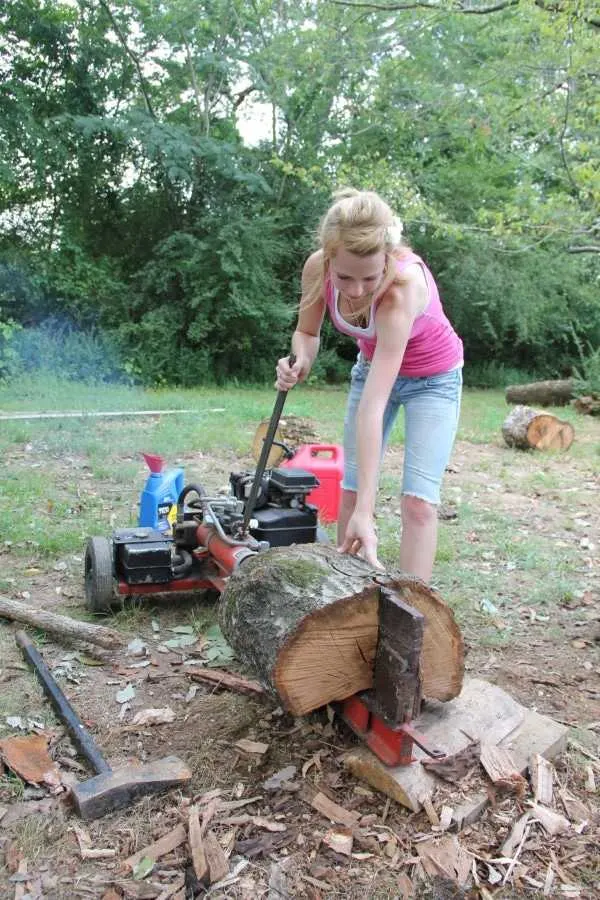A log splitter is a machine used to cut logs into smaller pieces. The log is placed on the log base, and the blade of the machine is raised and then dropped onto the log, splitting it in two.
Rather than wearing yourself out with an ax, you can split more wood using a log splitter. It will save you tons of energy and time – while still getting the job done.
It comes in various models and designs that fit your wood cutting needs and reduce labor. Also, it has many types, i.e., manual log splitters, electric, or gas-powered log splitters. Few types use hydraulics to supply splitting force.
Irrespective of all the types, the log splitters serve the same purpose, and you can easily chop firewood using this great tool. Read on to know the answer to how to use a log splitter because it must be popping up in your head!

Why Use A Log Splitter
You can use a log splitter for a variety of reasons, such as:
- If you have a lot of wood to chop up and don’t want to spend hours doing it by hand, you can use a log splitter.
- It makes wood chopping easy and quick, reducing the physical exertion and effort.
- Log Splitter is easily transferrable, so you can take it anywhere to chop wood. Unlike ax, which strains your shoulders to carry all day and take back for storage, a log splitter is easy for storage as well.
- This tool is easy to use, and you can start by reading the user manual.
- There would be the least chance of injury in using this ingenious equipment as it is easy and safe to use. You cannot lose grip and wouldn’t be vibrating to cut a hard log piece, so muscle fatigue is no chance.
- Log splitter tool doesn’t cause any harm to the environment, so it is environment friendly.
- Log splitters don’t make much mess as you can easily rake the wood chips into a pile that might fly off the machine. You can use this pile for fuel or add it to a composite pile.
Horizontal Log Splitter Vs. Vertical Log Splitter
When choosing a log splitter type, it is important to recognize the difference between what a horizontal and vertical splitter can do and which size you might need.
Some models offer dual functions and are larger. Before choosing any splitter, it’s important to know the differences between horizontal and vertical splitters.
Horizontal Log Splitter
The most common type of log splitter is a horizontal style and has to be lifted into place before use. This design supports the log while it splits into both sides, but if you use one with wheels, you can move it around easier.
Gas, electric, kinetic and manual hydraulic models are often horizontal-designed to split efficiently.
Horizontal log splitters are relatively new and often used in the construction industry. They are not as powerful as vertical types but have many options and can be used to split shorter pieces of logs.
Vertical Log Splitter
This type of log splitter is usually not as powerful as horizontal ones, but it is much easier. It is designed for homeowners for occasional use as it is smaller and compact.
Vertical log splitters are perfect for cutting larger amounts of wood. If you have more dense logs with large diameters, this type can be the best. It will leave your log at a ground level preventing you from lifting off these heavy pieces.
Different Types of Log Splitters
It is important to know the different types of log splitters before you go out and buy one. Different logs require varying degrees of pressure to split properly.
So, you need to know the types of log splitters to find how to use a log splitter. There are three main log splitters: hydraulic, gas, and electric.
Gas Log Splitters
Gas log splitters have a 4-stroke gas engine to power them. It builds pressure within a hydraulic oil pump, and a valve is activated that causes the cylinder to split the wood.
It can cut both vertically and horizontally. Gas-powered wood splitters require a lot of maintenance and safety gear, but you can use them in remote areas where electricity is unavailable.

Electric Log Splitters
Electric log splitters plug 110/120 Volt into a standard outlet and can be run indoors without worrying about fumes from an engine. They’re compact and convenient but more expensive than gas-powered and manual wood splitters, but they are also safer and more efficient.
Manual wood splitters are cheaper than electric log splitters and gas-powered ones, but they take a lot of effort to use.
Hydraulic Log Splitters
Hydraulic log splitters are manual splitters requiring a high amount of physical strength. They can either be horizontal or vertical and perfect for noncommercial use.
5 Steps On How To Use A Log Splitter
Here is a step-by-step guide on how to use a log splitter properly. Follow it and chip your woods like a pro! A rule of thumb is that only one person should operate the machine at a time.
1. Wear Your Safety Costume
Ensuring your safety is the foremost thing before doing any task, especially with a machine. So, make sure you wear your safety costume before operating a log splitter. It includes:
Safety Goggles. Wood chips will fly about during a normal log splitter operation. To avoid it hitting you anywhere, especially the eyes, you should wear this safety clothing.
Boots Or Closed Shoes. Large pieces of wood feel on the ground, and closed safety shoes are essential to prevent foot injury.
Heavy Duty Gloves. Gloves will protect your hands from any injury caused by harsh wood pieces.
Long Pants. Baggy clothes should be avoided while using a log splitter as you may accidentally catch them in the machine. Long pants are the best to wear in log splitting operations.
2. Position Your Log Splitter
Set your log splitter in a place that is flat and depression-free. The machine must be away from any wood clutter but near the wood to be chopped. Make sure the machine is sturdily fixed so you can feed the log with ease. It would be best to fix the wheels with bricks or blocks to avoid your splitter from rolling.
3. Place The Log
Carefully place the log against the endplate of the wood’s grain and put your hand on the log opposite the beam.
4. Turn On The Valve
Time to activate the manual lever or valve to help log push in the splitting wedge. Once the log is split, take the valve back to retract the cylinder and operate the lever in a manual type.
5. Remove The Split Log
After splitting the log, please remove it from the bed. Do the same with all the logs.
Conclusion
Log splitters are a popular tool for people who have firewood or logs that need to be split. It would help if you used these tools with care and caution.
This guide will assist you with how to use a log splitter. So please read it and get your job done efficiently. Use the comment section below to reach us with any queries!
